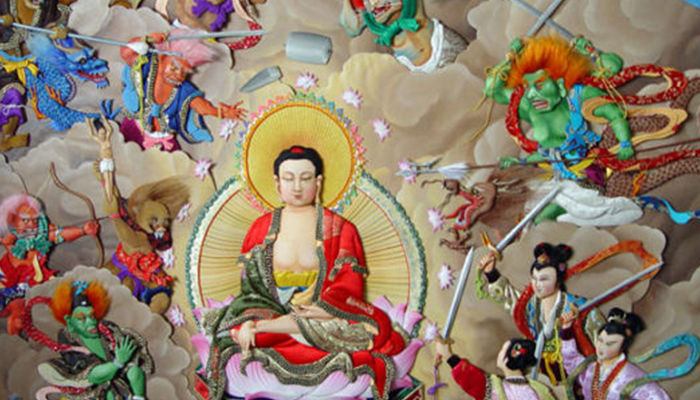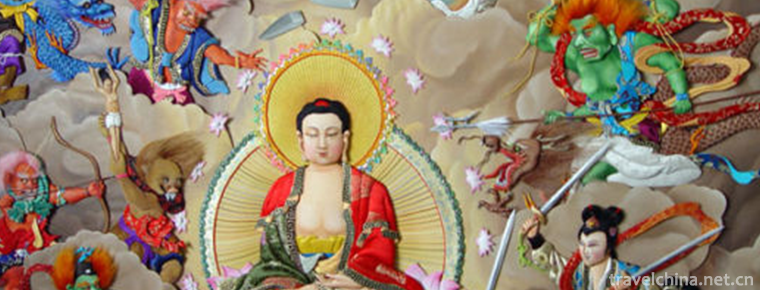Pile brocade
Pile brocade
Duijin, also known as Shangdang Duijin, is a handicraft hand Duijin is developed on the basis of traditional Chinese painting and embroidery. It is made of silk as the main fabric, cardboard and cotton as the skeleton, and processed by more than a dozen pure handicraft processes. The Duijin is exquisite, vivid and three-dimensional. It has high ornamental value. It integrates the long-standing culture, simple folk customs and wisdom and efforts of generations and decades of skilled craftsmen in Shangdang area, and is the crystallization of people's wisdom and folk customs in Shangdang area.
On June 7, 2008, Duijin was listed in the second batch of national intangible cultural heritage list with the approval of the State Council.
Historical origin
Like other folk arts and crafts, Shangdang Duijin's history has been very difficult to find detailed written records in historical documents. Only archaeological discoveries can prove its brilliant historical records. In ancient times, Shangdang belonged to "the capital of the emperor" in Yao, Shun and Yu periods. Shangdang was the capital of Li, Zhou was the Luzi State, and the Warring States was the other capital of Korea. Shangdang County was first established in the Warring States Period. In Sui Kaihuang Period, it was changed to Luzhou and Mingjia. 靖八年(1529)改为潞安府。 In the Ming Dynasty, Shangdang began to develop its weaving industry, which was famous for producing Luzhou silk. At that time, Shangdang was also called the four major silk weaving centers in China with Jiangsu, Zhejiang, Sichuan, Fujian and Guangdong provinces. Luzhou silk Weaver is fine, is the Royal tribute of the fine silk. The prosperity of silk industry provides the necessary material basis for the emergence of Shangdang Duijin. In the third year (707) of Tang Zhongzong Shenlong, Lilongji, king of Zizi, was appointed to Luzhou as the son of Zhu Yuanzhang for six years (408), and Shen Jianwang and Zhu Mou, son of Zhu Yuanzhang, were in Luzhou. They belonged to the regional characteristics of the Royal vassal Kingdom successively, which enabled Shangdang to gather skillful craftsmen and provided necessary personnel conditions for the production technology of Shangdang Duijin. The Ming and Qing dynasties were Jin merchants. In their heyday, their commercial footprints were all over the world. The brilliant achievements of Jin merchants made them rich merchants. Therefore, Shangdongjin was a luxurious high-end handicraft at that time. It naturally became a precious gift given by Shangdongjin merchants and bureaucrats because of its localized nature. This invisibly provided the necessary for the production and circulation of Shangdongduan brocade. Market conditions. By the end of the Qing Dynasty and the beginning of the Republic of China, Shangdang Duijin had reached a peak.
Manufacturing process
As the name implies, "heap" in the art of heap brocade fully reflects the strong relief characteristics of heap brocade art. Its production process is mainly stacking, supplemented by painting. The production process is to design the content of the presentation into patterns and painted into color brushwork, then to draw the design draft on the cardboard, then decompose and cut it into pieces according to the lines, paste "flying edge", "cotton floss" and paper twist on the cut cardboard, then wrap it with Jinwei silk, and knead out the soft and hard folds, and finally stack it in the frame in turn according to the level of the sample draft. Due to the special and slightly cumbersome production process, the Duijin artworks show fine, vivid and three-dimensional artistic features, while the color is gorgeous and the texture is delicate, which is called silk soft relief art. Especially when people and animals'hair is piled up, it is more delicate and lifelike. In the performance of fingernails, due to the extremely small decomposition of the shape, the process is quite difficult to produce, but artists can produce very perfect, the delicacy of the process is amazing. Therefore, it is not difficult for Ma to understand why Duijin handicraft can become a treasure given and collected by the upper class.
The "brocade" in heap brocade art fully reflects the special texture beauty of silk materials used in heap brocade art works, which are delicate, smooth and gorgeous in color. For the application of color, the author has seen the characteristics of literati paintings in the Qing Dynasty from the paintings of brocade artists, which are very elegant, indifferent, heavy ink and light color. Its sketch design combines silk material in the later stage of production, which enhances the auspicious effect of the work and further enhances the aesthetic feeling of the unique material. In the early art works of duijin, the color is mostly black, and saturated colors such as red, yellow, blue and green are often used, and dizzy dyes are applied on white silk. Some of them are decorated with gold and silver silk thread. Therefore, compared with paintings, Duijin works give people a better visual feeling both in the stereo sense of shape and in the saturation of color. With the maturity and development of silk manufacturing industry, heap brocade art has more space to create and play, and its achievements are even higher. Especially the Thangka made by the technology of heap brocade, its color is bright and rich, noble and beautiful, lustrous and lustrous, very Oriental charm. Because of its vivid image, delicate and vivid, colorful and highly relief effect, it is called "soft relief".
Art status
Dumping brocade is not a simple handicraft. It requires the producer to have a good art foundation and many years of experience. However, there are fewer than 10 inheritors and few backbones. Young people in the 21st century are willing to inherit and learn less. For this kind of folk craft, which requires intensive work, especially the organizational training of talents, and the lack of funds, it is difficult to realize the large-scale production of heap brocade art, which is the key to the development of heap brocade art. The collection of ancient heap brocade paintings is very few, and the folk collection is lost, which is not conducive to the overall protection of "heap brocade paintings" technology.
Inheritance significance
Traditional arts and crafts are the interpretation and confirmation of thousands of years of civilization and cultural history of the Chinese nation. They carry, embody and continue the material civilization and splendid culture created by the Chinese nation in various historical periods, and are the treasure and pride of the Chinese nation. Shangdang piling brocade art is a kind of relief art made of silk wrapped in cotton on the basis of piling silk in Tang Dynasty. It is a part of the cultural content of the Chinese nation and has a long history. Today, the original art connotation of piling brocade has been greatly improved. Enrichment and development. Pictures from small to large, brocade technology from simple to complex, subject matter from small to many, works from ordinary to refined. Through the hands of artists and skilled craftsmen, wise people turn ordinary into magic. They can heap ordinary silk and brocade cloth into an omnipotent and omnipotent world. They have created fine works of art that are becoming more and more perfect in style and color, and their cultural connotations are becoming more and more profound. Not only can she beautify the environment and provide people with appreciation and admiration, but also she is a high-end art work of great collection value.


-
1.Oyster omelet
Oyster fry is a common home dish, which originated in Quanzhou, Fujian Province, and is one of the classic traditional snacks in southern Fujian, Taiwan, Chaoshan and other regions.
Time 2018-11-02 -
2.Steamed chicken feet with oyster sauce
Oyster Emperor steamed chicken feet, a featured delicacy, the main raw materials are chicken feet, small red pepper, oyster oil and so on, suitable for all ages.
Time 2018-11-02 -
3.Futian Shangri La Hotel Shenzhen
The second Shangri-La Hotel Group, Shenzhen Futian Shangri-La Hotel, is located in the downtown area of Futian Business District. It can easily reach Shenzhen Convention and Exhibition Center, large s
Time 2018-12-16 -
4.West Mountain Scenic Spot of Guiping
Guiping Xishan Scenic Spot, National AAAA Scenic Spot, National Geopark. Located in Guiping City, southeastern Guangxi Zhuang Autonomous Region, Xishan Scenic Spots 1 km away from the outskirts of the
Time 2019-01-13 -
5.Tianjin Italian Style Area
Tianjin Italian Style Area is located in Hebei District of Tianjin City. It is a quadrangular area surrounded by Wujing Road, Boai Road, Shengli Road and Jianguo Road in Hebei District. There are near
Time 2019-02-21 -
6.Lu Brocade Weaving Techniques
Lujin brocade weaving technology, traditional handmade brocade weaving technology in Juancheng County, Shandong Province, is one of the national intangible cultural heritage.
Time 2019-05-15 -
7.Ningxia Xiaoqu
Ningxia Xiaoqu, a national intangible cultural heritage project, is a traditional rap art form with strong local characteristics.
Time 2019-06-08 -
8.Ou sculpture
Ou sculpture, commonly known as color oil-pickle sculpture, also known as "color relief", is a unique folk art in Wenzhou, Zhejiang Province, one of the local traditional arts and crafts. It
Time 2019-06-08 -
9.Mount sanshen
The three sacred mountains in Yading, Daocheng, are composed of three snow peaks, xiannairi, yangmaiyong and xianodoji, representing respectively Guanyin Bodhisattva, Manjusri Bodhisattva and Vajrayana Bodhisattva.
Time 2020-10-13 -
10.Longtan Karst Cave Scenic Spot
Longtan Karst Cave Scenic Area is located at the foot of longcuban mountain, Miyi Baima Town, Panzhihua City, Sichuan Province, with an altitude of 1500 meters. It is a provincial-level scenic spot and a national AA level tourist area.
Time 2020-10-15 -
11.Ruoergai grassland
Ruoergai grassland is like a magnificent emerald inlaid on the border of Northwest Sichuan, known as "oasis of Northwest Sichuan Plateau", and is one of the three wetlands in China.
Time 2020-11-07 -
12.Administrative division of Dazhou
In 1950, Daxian district was set up, which belongs to the northern Sichuan administrative region. Daxian special office is located in Daxian county and governs eight counties, including Daxian County, Xuanhan County, Kaijiang County, Pingchang
Time 2020-12-20